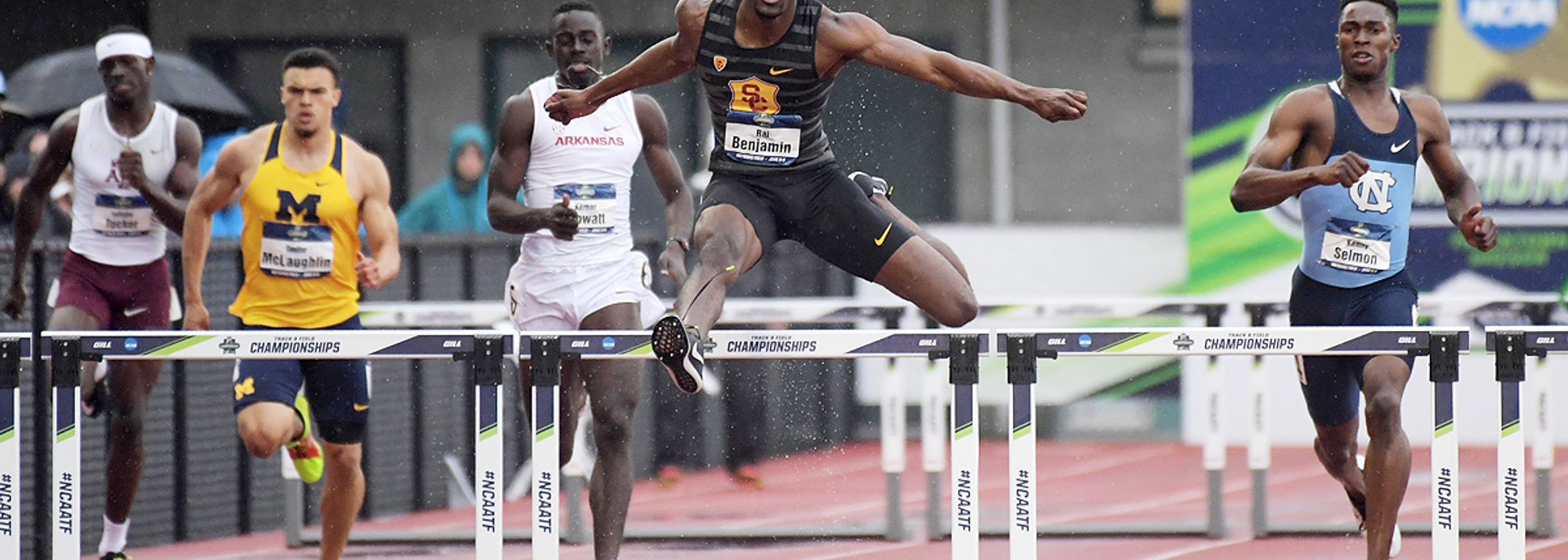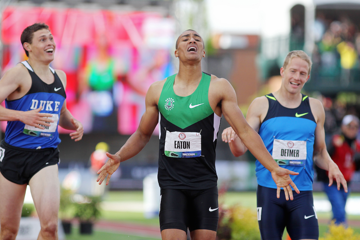Rai Benjamin in the 400m hurdles at the NCAA Championships (© Kirby Lee)
On a wet day in June at Historic Hayward Field, Rai Benjamin clocked 47.02 for the 400m hurdles – a collegiate record and the second fastest time in the history of the event*. This is how the race played out in his mind.
That was probably the most vivid race I’ve ever remembered.
I remembered every step and I remembered all my different phases in the race.
It was wet. It was kinda cold. I had lost the previous year, so this year I had to win.
The race started and I didn’t get out as hard as I usually would. I was being conservative because I didn’t know how the race would play out. Kemar Mowatt, who was in front of me, had run like 48-low before. Kenny Selmon, he was behind me, he’d run 48-something as well.
I spoke to Coach Hayes and during the season I’d be super-fast to the first hurdle and that would put me on twelve steps for the rest of the race. Twelve stepping is with my left leg and I’m not necessarily comfortable with doing it, so try not to do it. I did it at our Conference Meet – Pac-12s – and I almost fell. I lost confidence in it a little bit, but then Coach Hayes told me I just had to trust it and just go with it, so I did.
The first day in the prelims, I did twelve steps for about two hurdles and then I went back to thirteen.
In the final, the race started, I got off hurdle one and immediately I felt my rhythm changed. In my head I just went “damn, my rhythm changed, I’m on twelves now.”
It’s so funny, because you spend about three to four seconds between hurdles, usually three in the first half of the race. In three seconds, I had so many thoughts run through my head. It’s weird, because it seems so slow, but it happens so fast.
So, the moment I got off the hurdle, I felt that my rhythm changed and I thought “oh my gosh, I’m on twelves.” The next thing I did was to look in front of me to see where Mowatt was and to see where the rest of the field was.
That’s when I said to myself “we can’t do twelves at all. We just need to be as safe as possible during this race.”
I kept the pattern, and then about four steps before the hurdle, I increased my frequency, just to come up on thirteens again. I took the second hurdle and I realised I’m still on the twelve pattern ‘cause my rhythm hadn’t changed. I got up to the third hurdle, it was the same thing, and I’m looking at Mowatt to see where he is and I was like “dang, he’s too far in front.”
I took the hurdle with increased frequency again and when I got off hurdle three I said to myself “alright, you might have to pick it up a little bit.”
I didn't know where I was in the race.
I look in front of me again to see where Mowatt and the rest of the field was. For a second I thought he was well ahead of me because he seemed really far away – but then you have to remember: it’s the 400 hurdles, don’t look at the distance, look at the hurdle. I can’t believe I didn’t remember that till about the fourth hurdle!
I said to myself “dude, just pay attention to the hurdle.”
Hurdle four came up, I chopped again, because I was still on the wrong pattern. I took the hurdle and when I got off the fourth hurdle I remembered what Coach Hayes said – “just run your own race”. I then realised that Mowatt and I were coming off the hurdle at the same time, so I wasn’t that far behind him – if anything, we were even throughout the race.
When I got off hurdle four, my pattern changed and I was back to comfortable thirteens, so I was like “ok cool, this hurdle is gonna come up right”. I took it right, and for the rest of the race I decided to just pick it up as we go into the turn. I got off hurdle six and decided to run as hard as possible coming home.
For about the first five hurdles I didn’t really press it, I was cautious because I wanted it to be thirteens, but after I got off hurdle six, I just ran home.
I didn’t want to get caught. That was the whole goal.
I wasn’t necessarily worried about the time because Coach Caryl had told me “whatever you do, just run home and just run through the line. Don’t dip, just run through the line as hard as you can.” That’s the only thing I remembered.
I got off every hurdle after that – seven thirteen … eight thirteen … nine thirteen – and then I had to reach a little bit, but it wasn’t a lot, for the last hurdle. I reached, and I came off in thirteen and I all I could think was “sprint home now!”
My shoes got untied at the last hurdle, but I just sprinted through the line.
It said 47.02.
I looked up at the time, like, I looked at it and I thought “ok cool.”
Then the announcer said what he said and I realised “oh man, I just broke the collegiate record!”
Then he said that it’s the second fastest time ever and I was like “wow … solid! I really ran that fast just now?”
I was happy about it and when I walked over to the video board, I looked up in the stands and I realised “man, you just ran the second fastest time ever.”
But it didn’t occur to me, it didn’t sink in.
I was already thinking about running the 4x4 and to get recovery because that was legit 45 minutes later. I was just worried about getting off the track and getting back under the tent to cool down and get ready for the 4x4.
I didn’t really have a full moment to cherish what had happened. It didn’t sink in until several days later – to realise how fast 47.02 really is.
*nb: Abderrahman Samba has since recorded 46.98 to go #2 in the all-time lists.









